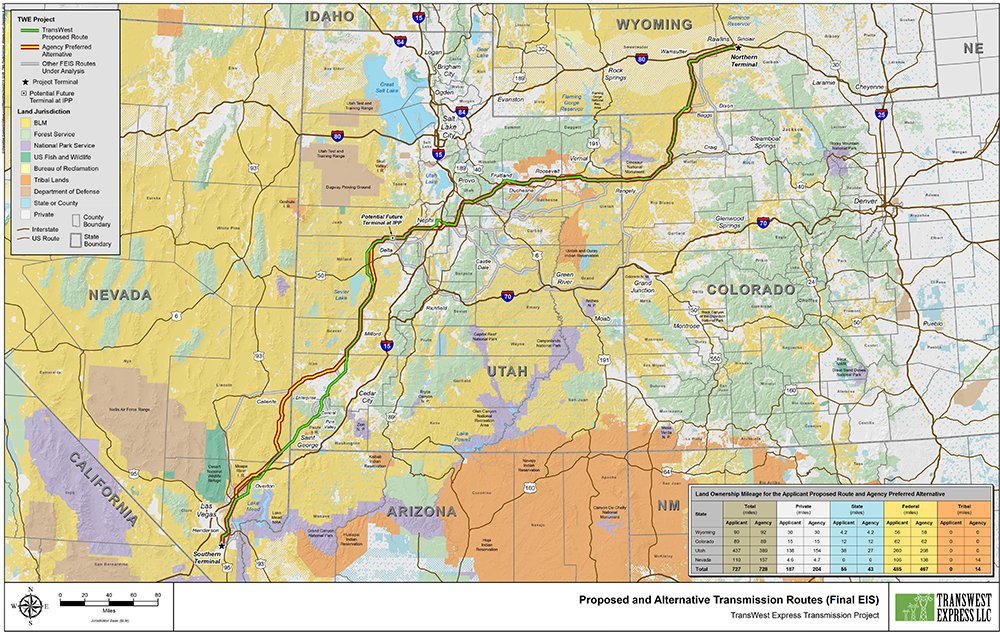Pahrump Rail Energy Storage Project
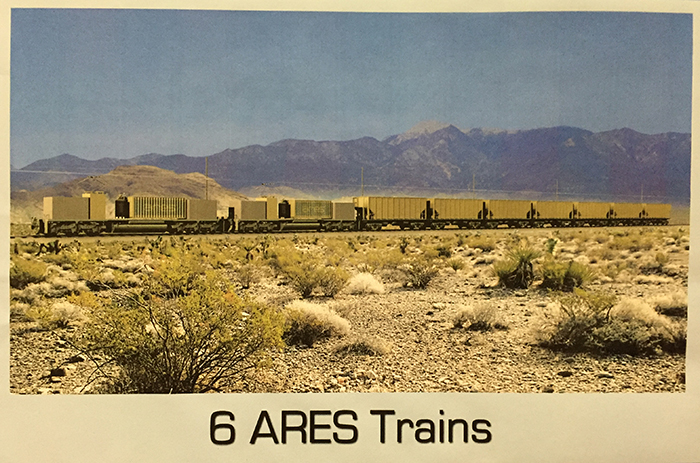
November 10, 2015 - Pahrump NV - At a meeting with the Bureau of Land Management (BLM), a new energy storage technology was discussed that will require public land on a large alluvial slope below Mt. Charleston near Carpenter Canyon in the Spring Range in Nye and Clark Counties. An Environmental Assessment is being prepared to review the project. More >>here.
The Comment deadline is November 11, 2015. Send comments to Greg Helseth, 4701 North Torrey Pines Drive, Las Vegas, NV 89130. ghelseth@blm.gov
Riverside East Solar Energy Zone Mitigation and Monitoring Plans
November 6, 2015 - Sacramento CA - A meeting of agencies and to discuss how to proceed with monitoring impacts of solar projects to resources in the Riverside East Solar Energy Zone (SEZ) in eastern Chuckwalla Valley occurred on October 28. This is an ongoing process to work out details of the massive Solar Programmatic Impact Statement (PEIS) developed and approved for federal lands in the western US. Our report on how solar projects will be monitored in this Colorado Desert/Mojave Desert transition valley >>here.
Federal Judge Voids Permits for Searchlight Wind Project
November 2, 2015 - Searchlight NV - Last Friday, U.S. District Court Judge Miranda Du vacated the federal permits for construction of the Searchlight Wind Project in Southern Nevada. Judge Du found that environmental analyses prepared by the Bureau of Land Management (BLM) and U.S. Fish & Wildlife Service (USFWS) inadequately evaluated the dangers that the industrial-scale wind project would pose to desert wildlife. She cited data missing from the agency surveys, inadequate assessment of potential threats to golden eagles, desert tortoises, and bats, and the need for additional explanation of the agencies’ conclusions. If the developer, Apex Clean Energy, wants to proceed with the project, the BLM would need to prepare a new Environmental Impact Statement to address the deficiencies she identified. The USFWS would also have to prepare a new Biological Opinion. This important decision will protect eagles nesting near the project site, the highest-density desert tortoise habitat in Nevada, the viewshed from adjacent parks and tribal sacred areas, as well as property values, recreation, and tourism near the town of Searchlight. More >>here.
New "Streamer" Video Obtained by Basin & Range Watch of Crescent Dunes Solar Project Birds Vaporizing
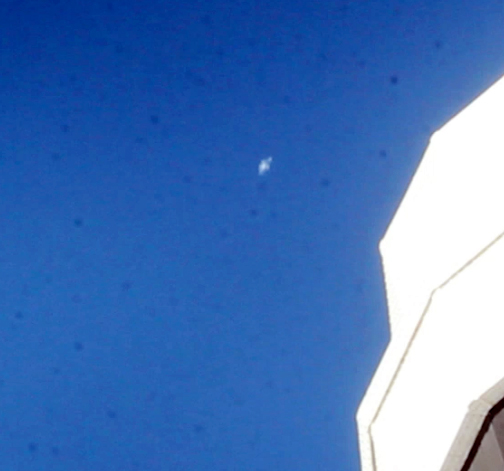
^Bird "streamer" disintegrating in solar flux. Still frame crop from video.
October 27, 2015 - Near Tonopah NV - The Ivanpah Solar Electric Generating System power towers have made the news in bird mortality as the intense solar flux creates damaging heat energy to anything that flies through it over formerly biodiverse Mojave Desert habitat in a valley surrounded by bird-rich mountain ranges. Now Basin & Range Watch has obtained a video through Freedom of Information Act Request that shows biologists contracted by SolarReserve filming and commenting on numerous birds flying into solar flux, apparently horned larks, turning white-hot, and vaporizing. This video is from last January during testing when mirrors were focusing solar flux in a "halo" pattern in standby position above and around the tower creating a deadly ring of bird-trapping flux. SolarReserve has replied since then they "fixed" the problem by rearranging the mirrors to create a less intense "pancake" pattern.
The real problem is the operational solar flux, not solar flux during testing when the mirrors are aimed in different configurations around the power tower. During operation, when all mirrors are aimed at the receiver on top of the tower, a high-energy solar flux cone. Simply changing testing configurations does nothing to mitigate the solar flux created in the air space around the tower during normal operation, when temperatures are hot enough to super-heat fluids such as molten salt (as at Crescent Dunes) or water into steam (as at Ivanpah). See more >>here.
Cadiz Project Groundwater Pumping
October 23, 2015 - San Bernardino County CA - Cadiz Inc. is trying to push ahead a project that would pump as much as 50,000 acre-feet of water from the desert aquifer just south of Mojave National Preserve each year for the next 50 years and store it as a groundwater "bank" to sell to thristy buyers. That plan has long faced strong opposition from environmentalists, including us, who say the plan is unstustainable for desert aquifers which are mostly ancient fossil water and not quickly replenished. Read the story of water pipelines and agency questions, as well as controversial groundwater geology in the southern Mojave Desert.
See the Desert Sun -- http://www.desertsun.com/story/news/2015/10/22/cadiz-mojave-water/74314906/
Eagle Mountain Pumped Hydro Project: FERC Denies Request for Rehearing
October 15, 2015 - Riverside County CA - The Federal Energy Regulatory Commission (FERC) just denied the request by Desert Protection Society, National Park Service (as Department of Interior), and the mining company Kaiser Eagle Mountain, LLC (Kaiser) for reconsideration of the license granted for the Eagle Mountain hydro project. Department of Interior also filed for a stay which was also denied.
The 1,300-megawatt project would operate as a closed-loop pumped storage facility, with water for the initial reservoir fill and replenishment supplied by groundwater wells. FERC seems to claim that they have jurisdiction over the groundwater as a "waterway" that can be regulated, and even cites federal power of eminent domain to acquire the necessary property rights to develop its project. See the court document.
See the Desert Sun for more.
California State Lands Commission Exchange in the Desert
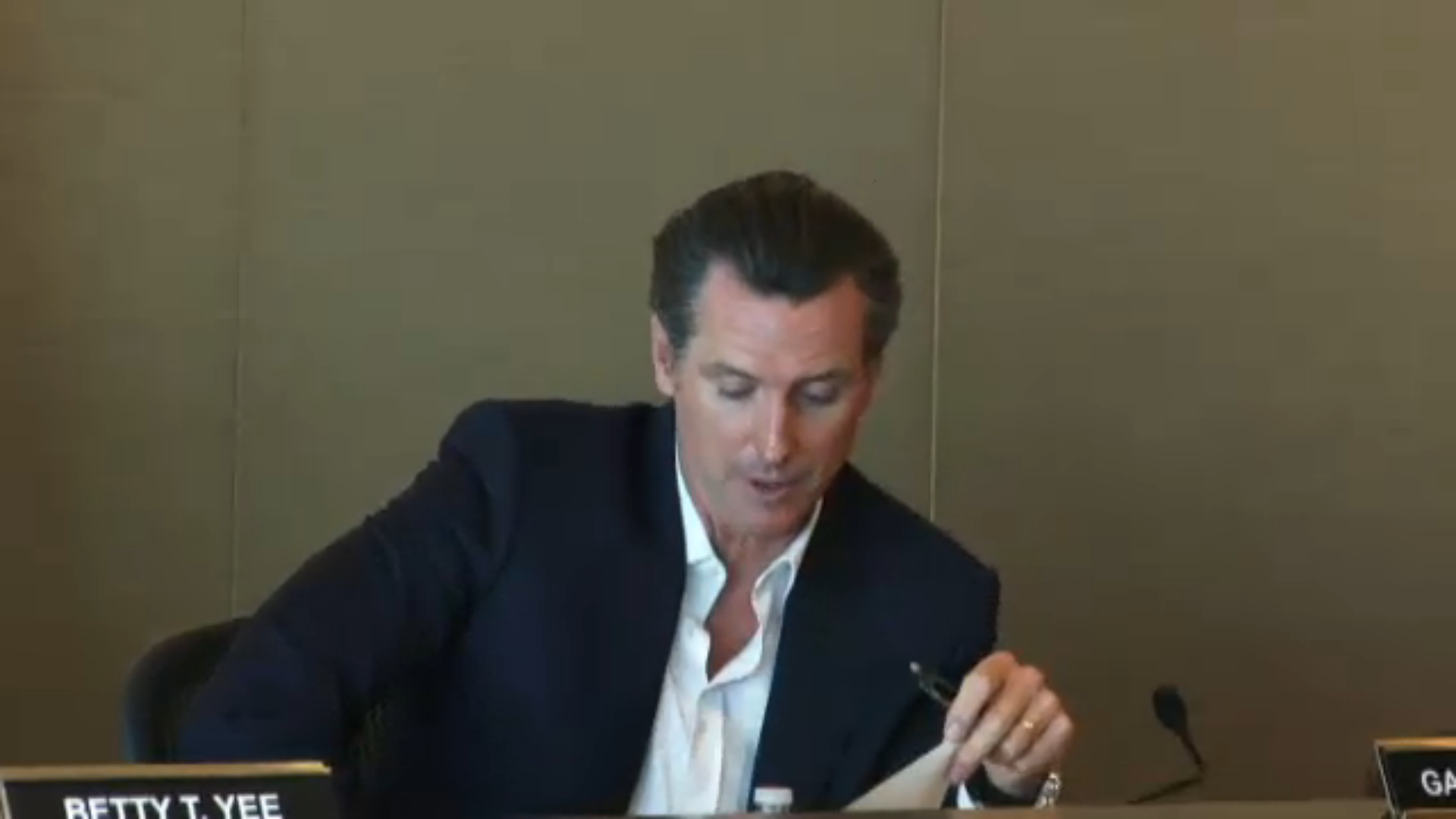
^Gavin Newsom was presiding, Lt. Governor, and former mayor of San Francisco. He said this exchange was a "win, win, win for everyone." (We are not so sure the land exchange is a win for Desert tortoises.)
October 1, 2015 - Sacramento CA - We were able to listen to a State Lands Commission (SLC) webcast discussing a Phase 1 land exchange between federal Bureau of Land Management (BLM) and state lands in the California Desert. Public comments could only be made in person. The proposed land exchange "would advance state and federal conservation and energy strategies of the Desert Renewable Energy Conservation Plan (DRECP) by consolidating federal lands within the National Conservation Lands (NCL) area and providing the state with lands that have operational, or the potential for operational, renewable energy facilities. The consolidation of federal lands will promote the continuity of wilderness and wildlife corridors. The conveyance to the state of developed land with renewable energy generation facilities, or proposed facilities, will generate revenue for the California State Teachers' Retirement System (CalSTRS)." The commission authorized a memorandum of intent to start the process.
Phase I of the exchange will include approximately 61,000± acres of State school lands and approximately 5,600± acres of Federal lands that have the potential for, or are previously developed with, renewable energy facilities. Future phases contemplate conveying approximately 150,000 acres of school lands to the BLM in exchange for approximately 16,000 acres of federal lands. The majority of lands subject to the proposed exchanges are located in San Bernardino, Inyo and Riverside counties. More >>here.
Sage Grouse Not Listed - Transmission Lines May be Built Through Deserts
^Transwest Express transmission proposal to connect wind energy from Wyoming to Nevada, and California, through sage grouse habitat and wilderness-quality desert.
September 27, 2015 - The very large wind project proposasl in Wyomi\ng, Chockecherry and Sierra Madre, may get a boost from the recent US Fish and Wildlife Service decision to not list the Greater sage grouse under the Endangered Species Act. This opens the way for new transmission projects such as Transwest Express to cut through undeveloped parts of the Great Basin in Nevada, such as the Clover Mountains in areas with Wilderness Characteristics. Sage grouse need unfragmeneted landscapes free. The wind proposal would have up to 1,000 wind turbines.
See:
West Mojave Plan Update, Comments Needed
September 27, 2015 - In the Federal Register on September 25, the Bureau of Land Management (BLM) announced they are reopening of the public comment period and two ddditional public meetings for the Draft Supplemental Environmental Impact Statement and Draft Plan Amendment, California Desert Conservation Area Plan, West Mojave Planning Area, Inyo, Kern, Los Angeles and San Bernardino Counties. On March 6, 2015, the Department of Interior, Bureau of Land Management (BLM), published in the Federal Register a notice of availability for comment on a Draft Land Use Plan Amendment (LUPA) and Draft Supplemental Environmental Impact Statement (EIS) for the West Mojave Route Network Project (WMRNP) for the West Mojave (WEMO) Planning Area of the California Desert Conservation Area (CDCA), to amend the Motor Vehicle, Recreation, and Grazing Elements of the CDCA Plan and to designate a transportation network within the planning area. Comments were requested by June 4, 2015. The BLM is reopening the public comment period for the draft LUPA and draft supplemental EIS for an additional 120 days.
According to BLM at a Desert District Advisory Committee meeting last week, the Desert Renewable Energy Conservation Plan (DRECP) will be completed, amending to the California Desert Conservation Area plan, then WEMO can come along, conforming to the revised plan.
Comment on the BLM web page: http://www.blm.gov/ca/st/en/fo/cdd/west_mojave__wemo.html
DRECP: Federal-State Land Exchange to Facilitate Renewable Energy Development in the Desert
September 22. 2015 - An October 1 meeting of the California State Lands Commission seeks to consider authorizing a memorandum of intent with the Bureau of Land Management for the proposed Phase I land exchange transaction involving the conveyance of up to approximately 61,000± acres of state school lands to the Bureau of Land Management in exchange for approximately 5,600± acres of federal lands pursuant to California Public Resources Code Division 7.7, located in San Bernardino, Inyo and Riverside counties.
See the agenda here: http://www.slc.ca.gov/Meetings/10-01-15/Agenda.htm
RETI 2.0 Workshop
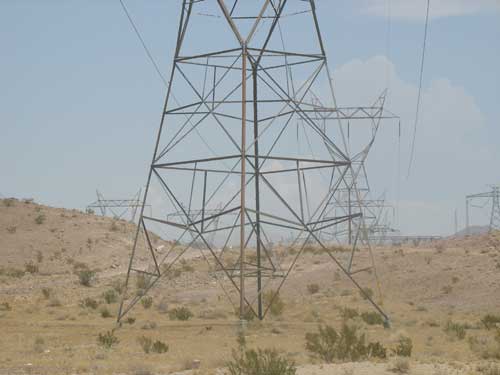
September 13, 2015 - Sacramento CA - On September 10 we participated in a workshop put on by the Renewable Energy Transmission Initiative team about RETI 2.0. Documents can be found >>here. Comments are due September 24, 2015.
California Energy Commission Commissioner Robert Weisenmiller concluded the workshop by saying there is a need to plan robustly for the long term, and not just be concerned so much with cost right now. "We build it, they will come," referring to new transmission lines. He especially emphasized that reliability of the grid was crucial, so new renewable energy generation would be beneficial if it could integrate storage and peaker plant-type storage at that.
We support clean energy in the built environment (rooftop solar and energy efficiency especially), and not as large-scale renewable energy projects on desert ecosystems requiring long expensive transmission lines. More >>here.
California Senate Bill 350 Clean Energy and Pollution Reduction Act of 2015, Passed as Amended: 50% RPS by 2030
September 12, 2015 - Sacramento CA - Yesterday the California state Assembly passed the Clean Energy and Pollution Reduction Act of 2015. In 2011, Governor Brown signed legislation to increase Renewable Portfolio Standard in California to 33% by the year 2020. Currently, most energy utilities have bought or have built enough energy resources to meet the 33% RPS before the target year. This legislation increases the RPS to 50% by the year 2030.
September 13, 2015 - UPDATE - The bill would mandate 50% utility power coming from renewable energy and a 50% increase in energy efficiency in existing buildings. A 50% reduction in petroleum use was amended out of the bill in order to get moderate Democrats to vote for it.
Governor Brown stated: “Taking carbon out of the modern economy requires heroic efforts and tireless struggle. SB 350, in both efficiency and renewable energy, ratchets up the California commitment. We have the technological means and now we have the legal mandate to reduce carbon pollution.”
Palen Solar Power Project Proposed to be "Peaker" Plant With Storage
September 9, 2015 - The California Energy Commission held a public hearing today to consider whether to grant Abengoa's request for an extension and to file a petition to amend the original application. Environmental groups and tribal representatives had requested a whole new application be required of the company since the design has changed again and years have gone by since the original Solar Millennium application was filed.
Abengoa explained it would change the solar trough design to use new updated technology and more efficient troughs, resulting in a smaller footprint of land that would need to be graded. Molten salt tanks would be added by the power block but Abengoa intended this project to be a "peaker" plant that would be a minor reconfiguration, providing a capacity product to the market that is flexible during peak hours like a peaker natural gas plant. Therefore the solar field could be smaller since so much extra energy would not be stored (into the night hours).
At the end of the hearing, however, the Commissioners granted the extension and request of Abengoa to file a petition to supplement the original application. It must be done before December 22, 2016 when the permit expires. More >>here.
Ivanpah Solar Flux and Bird Mortality
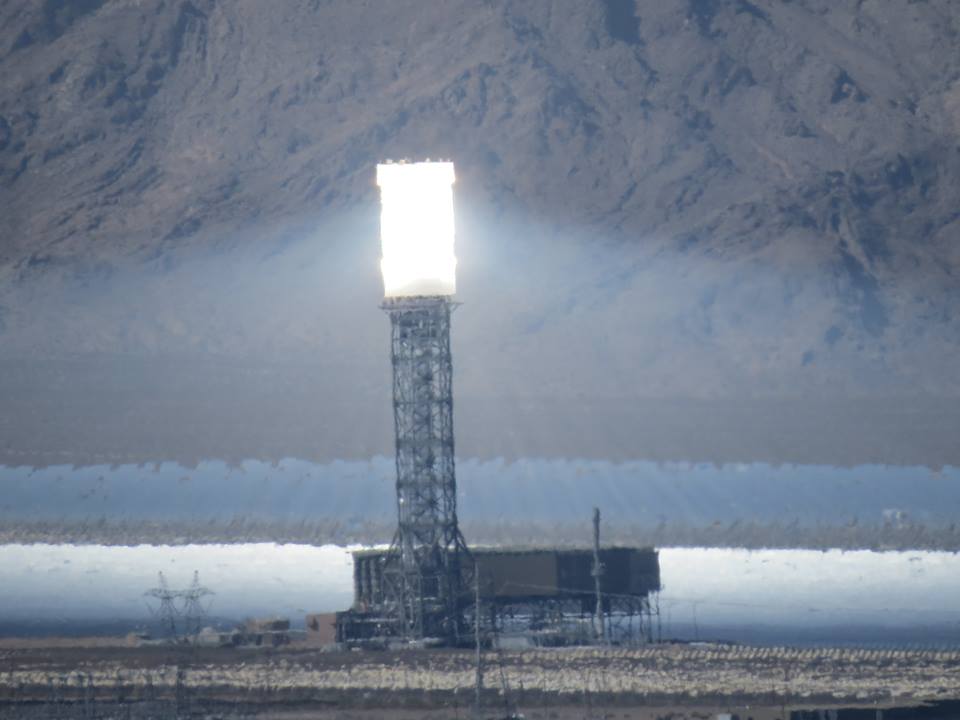
^Ivanpah Solar Electric Generating System - tower two - solar flux, September, 2015. The faint halo of white may be due to light energy intercepting dust in the air or water vapor, and could be contribuiting to the lower prefromance of the project.
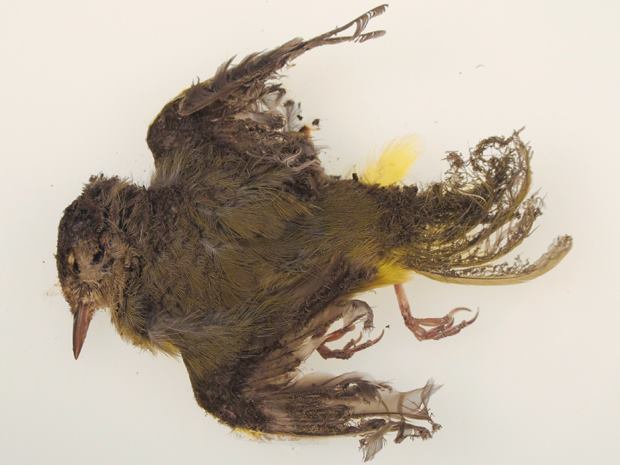
^Singed warbler at Ivanpah solar project (from US Fish and Wildlife Service).
September 7, 2015 - San Bernardino County CA - Migration is happening now, with a diversity of warblers, vireos, flycatchers, swallows, and other birds heading south through the Mojave Desert. Many can be seen resting and feeding at oases, springs, and wooded groves across the desert but also during the day these birds fly across vast open deserts and we have seen them flit through creosote in Ivanpah Valley looking for insects. Unlucky birds may unknowingly fly into the solar flux of concentrated solar thermal power towers and become burned.
When 300,000 mirrors focus the sun on one water filled receiver tower a “solar flux” is created. The ghostly white cone pictured here around Ivanpah Tower 2 is a concentration of heat with temperature ranging from 800 to over 1,000 degrees (and higher right next to the receiver) for a 2,000 foot radius around the tower. When the mirrors are moved to a stand by position, the flux can expand. The US Fish and Wildlife Service has called this a “Mega –Trap” for insects and birds. Birds have been observed vaporizing in the flux and have received the nickname “streamers”. The company biological contractors estimate that about 3,500 birds are killed per year by this project. Some do not burn, but collide with the mirrors. But many have dead birds have been found with singing on their bodies. The surveys cover just over 20 percent of the project for just a few days each month. Could this be an undercount? One biologist estimated 28,000 could be killed per year. More Updates >>here.
Tornado Impacts to Desert Sunlight Solar Farm
August 28, 2015 - Chuckwalla Valley, Riverside County CA - As strange as it may seem in the California Desert, and more likely in Oklahoma, a tornado that had ripped through the Desert Sunlight Solar Farm last April caused extensive damage.
According to the Bureau of Land Management (personal communication), there were 154,843 modules damaged. All debris located outside of the project fence has been removed with no residual effect. All major broken glass has been removed from within the fence and plant. Glass and damaged structure removal has been manual with materials moved to staging areas via carts, trucks and trailers.
Broken glass is being shipped using 20 yard bins to Clean Harbors landfill in Button Willow CA. Recycled modules are being shipped via boxes to Veolia ES Technical Solutions in Phoenix AZ. There is no indication of soil contamination. This clean-up effort is progressing.
Ocotillo Express Wind Project Hearing in November
August 28, 2015 - On Novermber 3, 2015, oral arguments will be heard in the case involving the Ocotillo Express Wind Project in Imperial County CA. You can go to the US Courthouse in Pasadena CA at 9 AM. The United States Court of Appeals for the Ninth Circuit will be hearing arguments from Quechan Tribe of the Fort Yuma Indian Reservation, Desert Protective Council, and the Laborers’ International Union of North American, Local Union No. 1184.
Some background: http://indiancountrytodaymedianetwork.com/2012/06/06/ocotillo-express-wind-facility-opposition-grows-116580
Palen: Abengoa Switches From Power Tower to Solar Trough Technology
August 27, 2015 - Riverside County CA - Attorneys for Abengoa sent in this letter to the California Energy Commission (CEC) to announce they were changing their design of the Palen Solar Power Project near Desert Center in the Colorado Desert from power tower to solar trough technology, which would have molten salt storage. This may complicate the review, as other trough plants using thermal salt storage need wet cooling instead of dry cooling technology. The Solana project in Arizona requires 3,000 acre-feet per year of groundwater for their wet-cooling towers. The Mojave solar trough project at Harper Lake CA uses about 2,000 acre feet a year. This is a large amount in drought-striken California, and is considerably more than the BrightSource solar power tower asked for with dry cooling technology.
Since it is has been five years after the original application, Abengoa must go back to the drawing board according to CEC policy. The CEC has permitted a solar trough design at the site already -- the former Solar Millennium project. The Bureau of Land Management never finalized that environmental impact statement, however. The project is in a Solar Energy Zone designated under the Solar Programmatic Environmental Impact Statement review.
Ivanpah Solar Power Tower Bird Deaths

^Roadrunner.
August 24, 2015 - Ivanpah Valley CA - The latest bird kill report (winter 2014-15) for the Ivanpah Solar Electric Generating System includes 25 roadrunners (Geococcyx californianus) and a host of other species. Burning or singing from the solar tower flux was only detected on one roadrunner. The rest of the kills are listed as “unknown”. Other species include Green wing teal, American kestrel, Hermit Thrush, Yellow rumped warbler and Lazuli Bunting to name a few. More >>here.
Comment on the Palen Solar Power Tower Proposal
August 22, 2015 - Riverside County CA - The California Energy Commission is considering Abengoa’s petition to extend the deadline for construction on the existing Palen Solar Power Plant permit. The commission is accepting comments until September 4, 2015 and will likely decide the issue at the September 9, 2015 meeting. The existing Palen Solar Power Project permit was issued in 2011 for a solar trough project that Abengoa doesn’t want to build. Abengoa only wants to extend the permit deadline so that they can amend it to ask for a new power tower project at that site. See >>here for a sample comment letter.
Rooftop Solar: The War on Net Metering
August 15, 2015 - Las Vegas NV - Basin & Range Watch participated in a Nevada Public Utilities Commission meeting where hundreds of rooftop-solar proponents came out to protest a petition by the utility NV Energy that would place a cap on new owners who could benefit from net metering, and add three new fees to their bills. We support solar in the right places -- such as urban rooftops -- which could keep solar projects off of desert ecosystems, if allowed to blossom. More >>here.
Searchlight Wind Project Granted Extension
August 14, 2015 - Las vegas NV - We attended a Nevada Public Utilties Commission meeting on the 12th, where the commission would hear comments and consider a request for a two-year extension by Apex Clean Energy to complete compliance items. We submitted comments that Apex (as Searchlight Wind LLC) has delayed start of constructiom for more than two and a half years since the Bureau of Land Management issued their Record of Decision, and the project was originally proposed seven years ago. We argued there has been significant new information since this time about impacts to golden eagles and desert tortoises which has not been considered. The commission voted, however, to extend the time allowed for Apex to start construction despite this.
Our Comments on the Draft Dry Lake North Mitigation Strategy
August 14, 2015 - As part of the Solar Programmatic Environmental Impact Statement post-approval plan, to streamline development of large-scale solar projects on eastern Nevada valleys >>here.
Crescent Dunes Solar Power Tower Water Groundwater Discharge Permit
August 2015 - Tonopah NV - The Crescent Dunes Solar Energy Project is applying for a five year permit to discharge up to 0.5 million gallons per day of industrial process wastewater, including cooling tower and boiler blowdown water, reverse osmosis reject water, demineralized water, oil/water separator water, and floor drain water, to three double-lined evaporation ponds. The permit would also authorize the discharge of up to 0.2 million gallons per day of demineralized water for heliostat washing, and 0.2 million gallons per day of untreated water for dust control. See the legal notice >>here.
Coming To a Desert Near You: San Joaquin Solar Least Conflict Analysis
August 11, 2015 - The California Energy Commission has initiated a private lands analysis in the San Joaquin Valley of California, to try to find the least conflicted lands that could site solar projects. Later this anlysis will move to the California Desert. We beleive this is one attempt to rescue the private lands part of the Desert Renewable Energy Conservation Plan that bifurcated and is presently only pursuing environmental review of public lands.
New Renewable Energy Bill Destructive of Desert
July 31, 2015 - The Public Land Renewable Energy Development Act ( S. 1407, H.R. 2663) would further streamline devlopment of solar, wind, and geothermal energy resources on public land. The bill would include priority areas, exclusion areas, and variance zones, but this has already been done in the Solar Programmatic Impact Statement for several western states, in addition to the hugely complex Desert Renewable Energy Conservation Plan for California. The draft Resource Management Plan for Southern Nevada has proposed six more Solar Energy Zones before earlier plans had even begun to fill pre-existing zones. Adding yet another level of land management before these former plans are fully utilizied seems to us a waste of money and time, as well as further destroying wildlands. Of course, none of these plans would be needed if governments pushed for energy efficiency and rooftop solar policies first.
The bill calls for programmatic review of threatened and endangered species and senstive resources, a tactic which we have observed to be lacking when it comes to protecting these resources for future generations.
See The Mojave Desert Blog for more.
McCain Valley Wind Project Gets Power Purchase Agreement
July 30, 2015 - Eastern San Diego County CA - Seeking to build a massive wind project in wild beautiful backcountry, developer Iberdrola Renewables has signed a power purchase agreement with Southern California Edison. The wind project would sprawl over 14,000 acres. The small region is very biologically diverse and with local communities that have opposed such industrial energy development in their rural countryside, and Basin & Range Watch continues to advocate for energy efficiency and rooftop solar instead of bulldozing new roads and building tall wind turbines in wild lands.
See http://www.sandiegouniontribune.com/news/2015/jul/29/tule-wind-farm-contract-signed/
Crescent Dunes Solar Energy Project Operation May Be Delayed Until December
^Solar power tower not operational in June 2015.
July 25, 2015 - Tonopah NV - Four years ago, the Bureau of Land Management (BLM) issued this press release saying the Solar Reserve Crescent Dunes Project began construction. It was supposed to be complete a year ago and the latest target date for going on line was July, 2015. It is still not operational. According to the BLM public information officer, the company mentioned December as a possible start date, over one year later than the original target date for producing energy. The project received a $785 million Department of Energy loan. Basin & Range Watch contacted Solar Reserve, and they replied they were not disclosing the secific date to be online yet.
Park or Solar Energy Development Zone -- Can You Tell the Difference?
July 13, 2015 - Basin and Range Province, Nevada - One photo is from the Dry Lake North Solar Energy Zone, one is from the new Basin and Range National Monument, and one is from the Gold Point Solar Energy Zone, all in the Great Basin Desert in Nevada. Is the new monument (with special protection) more beautiful than the Solar Energy Zones (subject to grading and bulldozing), or is the entire region all spectacular? Why does the Bureau of Land Management believe the Solar Energy Zones have little conservation value? All Great Basin Desert has conservation value in our opinion. See the photo comparison >>here.
Gabbs Valley Range in Nevada, a Beautiful Mountain Next to a Proposed Largescale Solar Project
July 13, 2015 - Luning NV - Site visit to this wild remote range in west-central Nevada, >>here.
Obama Designates New Basin and Range National Monument in Southcentral Nevada
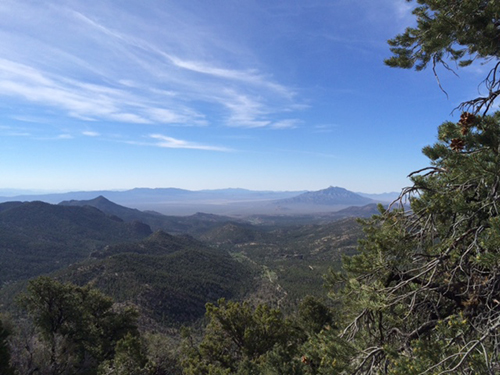
^View from the Quinn Canyon Range Wilderness area overlooking the new Basin and Range National Monument.
July 10, 2015 - new 700,000-acre nationl monument has been designated today in remote and beautiful basins -- Coal and Gardner Valleys -- surrounding by wilderness areas and mountains. See the story in the Las Vegas Sun. See also Protect Basin and Range.
Luning Solar Energy Project In Nevada Approved
July 4, 2015 - In remote west-central Nevada, Invenergy Solar proposes to construct, operate, and decommission a utility-scale photovoltaic solar generation facility on approximately 560 acres of Bureau of Land Management-administered public land in Mineral County, Nevada. See >>here.
BLM took recommendations from The Wilderness Society and NV Energy to site this project on what they described as a "low impact" area. This is not disturbed land and is great habitat for pronghorn. Off site mitigation will not make up for the fact that this habitat will be destroyed. This Luning site is not in a Solar Energy Zone as determined by the lengthy Solar Programmatic Environmental Impact Statement, as the developer claimed that no Solar Energy Zone filled its needs. Therefore Invenergy had to go through the variance process to demonstrate to the BLM why they needed another site to develop. The Wilderness Society helped the company dvelop mitigation plans.
BLM approves first solar variance project in Nevada - https://eplanning.blm.gov/epl-front-office/eplanning/planAndProjectSite.do?methodName=renderDefaultPlanOrProjectSite&projectId=46840
See more at: http://wilderness.org/update/blm-approves-first-solar-variance-project-nevada#sthash.lGVnuVCG.dpuf
Large Parcel of County Desert Land to be Auctioned Off for Solar Development Near Laughlin, Nevada
July 4, 2015 - Clark County NV -
The former site of the proposed ENN Solar Center on 9,000 acres of desert on a slope of the Colorado River is now to be auctioned off in smaller parcels for solar projects. The Chinese company ENN failed to obtain a Power Purchase Agreement from any utility.
The land was transferred to Clark County from the Bureau of Land Management. The desert here is not disturbed. It is all creosote/bursage habitat and is on the bajada of the Dead Mountains Wilderness Area located in bordering California.
The sites are one to two miles from the Colorado River. Any large scale solar built this close to the river will create the "lake effect" causing bird kill collisions with solar panels. This will potentially threaten the Endangered Yuma clapper rail.
http://www.reviewjournal.com/news/las-vegas/county-auction-land-near-laughlin-solar-development
Eagle Crest Energy Company Purchases Land for its Hydro Project
July 2, 2015 - The company wanting to construct a 1,300-megawatt pumped hydroelectric storage project made a step forward by purchasing the old Eagle Mountain iron ore mine, an open pit next to Joshua Tree National Park. During the worst drought in California history, the project would use billions of gallons of groundwater to store in the mine pit but is expected to lose over 1,500 acre feet of water a year through seepage and evaporation.
Environmental Groups Sue to Halt Panoche Valley Solar Projecy
June 25, 2015 - San Benito County CA - The Sierra Club and the Santa Clara Valley Audubon Society have reignited their effort to halt the $650 million, 2,400-acre Panoche Valley Solar Project by filing a lawsuit against San Benito County and the Board of Supervisors in local superior court, explaining that environmental impacts of the project still have not been adequately addressed. The environmental groups are challenging the certification of the final supplemental environmental impact report (SEIR) for the project, as well as the approval of the project's amended use permit. The groups claim the final environmental report for the project provides "inadequate mitigation measures regarding the Project's potentially significant environmental impacts to biological resources," such as wildlife and groundwater.
See: http://benitolink.com/environmental-groups-again-seek-halt-solar-project
Blythe Mesa Solar Project Lawsuit By Colorado River Indian Tribes
June 25, 2015 - Blythe CA - The Colorado River Indian Tribes (CRIT) launched a lawsuit over Riverside County's approval of a 3,600-acre solar energy project that the Tribes say failed to consider the impacts on cultural and natural resources. The lawsuit, filed earlier this month in county Superior Court, seeks to block development of the Blythe Mesa Solar Project. The project developer, Renewable Resources Group, is named as a defendant.
See: http://www.pe.com/articles/county-771385-project-tribes.html
Golden Sun Wind Project Proposed for Chuckwalla Bench
June 23, 2015 - Imperial County CA - Information obtained from the El Centro Bureau of Land Management (BLM) office indicates that the company Exelon intends to put in an application to build a wind project in the Chuckwalla Bench area of the Colorado Desert in California, a controversial location due to rare endemic Munz cholla (Opuntia munzii) and wild landscapes appreciated by desert hikers.
BLM has received a Plan of Development for a wind project on approximately 4,000 acres from the company but is delaying processing the application until after the final Desert Renewable Energy Conservation Plan comes out in winter. Desert tortoise presence-absence surveys were undertaken in spring of 2014, and 28 live tortoises were found, indicationg a total estimated population on the site of 67 adult tortoises. 11 tortoise carcasses were also found, having died during the past 1-2 years, apparently a larger die-off than in preceding years. Possibly a continuing drought in the desert and shell disease -- cutaneous dyskerotosis -- may be to blame. See more on the Chuckwalla Valley area >>here.
Aerial Views of the Desert
June 17, 2015 - EcoFlight took several beautiful photos over Silurian Valley and Soda Dry Lake in the California Desert. Contrast these large sweeping natural vistas with the fragmentation that occurs with large-scale solar power projects.

^Silurian Valley and Soda Mountain area of the Mojave Desert, San Bernardino County CA, photo courtesy EcoFlight.
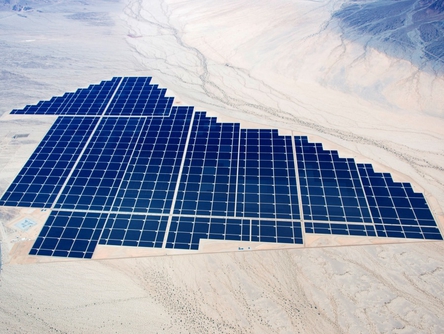
^In contrast, an aerial photo of the Desert Sunligt Solar Farm on Chuckwalla Valley, Riverside County CA. (Photo from http://www.intersolar.us/en/home.html)
Problems With Large-scale Solar Thermal Projects Operating
June 16, 2015 - A recent Wall Street Journal article highlighted issues some of the large-scale concentrating solar thermal projects are having. The Ivanpah Solar Electric Generating System in San Bernardino County CA is only producing 40% of the power it was supposed to, mainly due to cloud cover and technical difficulties with the long steam pipe system. Basin & Range Watch had written comments during the early review of the project to the California Energy Commission back in 2009 and 2010 on how it was known at the time that the eastern Mojave desert areas had a stronger monsoonal flow in summer with more cloudy days, than the clearer West Mojave where older CSP plants have been operating since the 1980s.
Abengoa's Solana project in Arizona, a parabolic trough CSP plant, is underperforming by around 50%.
The photovoltaic California Valley Solar Farm in Kern County CA on Carrizo Plain is producing more electricity than rated for, although we wonder if this is due to being closer to the coast. Problems with flash flooding, dust, and intense heat might be hampering desert photovoltaic projects.
Los Angeles Does Not Want Power From Soda Mountain Solar Project
June 12, 2015 - San Berbardino County CA - In a surprising development, Los Angeles Department of Water and Power (LADWP), the main utility that would purchase electricity from the Soda Mountain Solar Project, said Thursday the project would be too damaging to bighorn sheep and cost too much. LADWP owns the existing transmission lines that run through the valley. Bechtel, the company wishing to construct this project, said it would seek other utilities.
See the Los Angeles Times: http://www.latimes.com/local/california/la-me-solar-20150612-story.html
Moving Towards Approval: Final Environmental Impact Statement Out for Soda Mountain Solar Project
June 6, 2015 - San Bernardino County CA - The Bureau of Land Management (BLM) released the Final Environmental Impact Statement (FEIS), moving a step closer to approval and a Record of Decision which would allow the company Bechtel to build a 3-square mile photovoltaic project next to the boundary of the Mojave National Preserve, depsite objections by environmentalists and supportrs of the park unit. This project was one of the most strongly opposed large-scale projects in the desert since it will impact the beloved Preserve and hinder bighorn sheep movement between mountain ranges.
Mitigation is feeble, reducing the size of the project, setting aside funds for a potential overpass for sheep to cross the project and Interstate-15, as well as build drinking guzzlers for sheep.
See The Press Enterprise.
See the Final EIS on the BLM web page:
http://www.blm.gov/ca/st/en/fo/barstow/renewableenergy/soda_mountain.html
See the National Parks and Conservation Association page on the project and a proposal for an Area of Critical Environmental Concern >>here.
Three Solar Projects with Expedited Approval on Dry Lake Solar Energy Zone
June 2, 2015 - Clark County NV - As part of an approved Solar Energy Zone under the federal Solar Programmatic Environmental Impact Statement, the basin north of Las Vegas has had three solar companies bid on leasing land including the ability to build projects with expidited environmental review. These photos show parts of the 3,083 acres that have been approved for the development of three solar projects. All three projects were approved today by the Interior Department. They are on the recently established Dry Lake Solar Energy Zone on Bureau of Land Management Lands in Nevada. The Dry Lake Valley has many transmission lines running through it along with five natural gas plants in the area. While it has its share of disturbance, it still is a natural part of the Mojave Desert that will soon change even more for large-scale energy. More >>here
Sage Grouse Protection Plan
May 30, 2015 - Cheyenne WYO – The Bureau of Land Management (BLM) and the U.S. Forest Service (USFS) on Thursday released final environmental reviews for proposed land use plans that they say will help conserve greater sage-grouse habitat and support "sustainable economic development on portions of public lands in 10 states across the West". The land management plans, developed during the past three years in partnership with states and with input from local partners have been controversial since some enviornmental groups decry the decision to make these "layered management" approaches instead of listing the bird under the Endangered Species Act.
See the US Deparetment of Interior press release; in the Federal Register.
Federal Agencies Consider Guidance for Take Permits for Migratory Bird Conservation Act
May 30, 2015 - The US Fish and Wildlife Service has been considering plans to permit migratory bird kills. It is now in the Federal Review process.
"We are considering approaches that will minimize the administrative burden of compliance with this regulatory process for industry, other Federal agencies, and the Service, and will also consider continuation of our current efforts to work with interested industry sectors to develop voluntary guidance for avoiding or minimizing incidental take of migratory birds. These approaches will not affect 50 CFR 21.15, which was issued to allow the Armed Forces to incidentally take migratory birds during military-readiness activities."
BrightSource Withdraws Hidden Hills Solar Power Tower Application
May 30, 2015 - Just a few days after Inyo County requested termination by the California Energy Commission of the Hidden Hills Solar Electric Generating System, BrightSource Energy sent in its withdrawal notice. This ends the project proposal.
Inyo County Asks to Terminate Hidden Hills Solar Power Tower
May 28, 2015 - Inyo County today requested the California Energy Commission terminate the Hidden Hills Solar Electric Generating System application, citing the county General Plan Amendment extensively analyzing land use and renewable energy development guidelines, especially the part of the resolution that would allow only photovoltaic installtions and not concentrated solar thermal plants. The plan amendment was partly funded by a CEC grant and is in concert with Desert Renewable Energy Conservation Plan.
See the letter to the California Energy Commission >>here.
Ivanpah Valley: Three Solar Projects
May 22, 2015 - San Bernardino County CA and Clark County NV - Our photos this month showing how largescale solar energy projects fragment Mojave Desert ecosystems: Ivanpah Solar Electric Generating System, Stateline Solar Farm, and Silver State South Solar Farm, >>here.
Crescent Dunes Solar Power Tower Flux
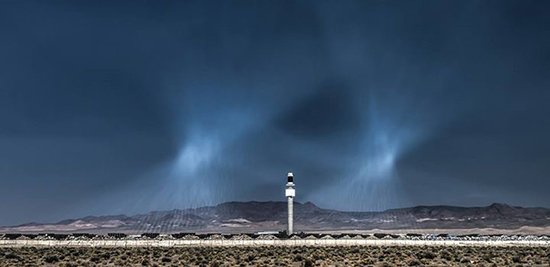
May 21, 2015 -Tonopah NV - Good photo (above) by Jack Freer taken this month showing the intense solar flux around the tower of the SolarReserve solar power plant, as tens of thousands of mirrors concentrate the sun's rays toward areas around the receiver during testing.
Coolwater-Lugo Transmission Project Rejected by California Public Utilities Commission
May 21, 2015 - The Southern California Edison (SCE) large Coolwater-Lugo Transmission Project that could have cost as much as $1 billion to construct was denied by the CPUC in a unanimous decision, saying "The Commission’s dismissal is without prejudice, which means that SCE may refile the application if future studies of the transmission system show the project to be needed."
Activists in the Victor Valley, Barstow area and Morongo Valley area, and organizations such as Alliance for Desert Progress, Lucerne Valley Economic Development Agency, and MC3 celebrated this final decision. It would mean SCE would have to start all over again with a brand new application if it sought to build this line.
We recall how the Mojave Desert Blog caught early on how this transmission project's reason for being was coming into question in March of this year: "The California Independent System Operator (CAISO) - the organization responsible for managing the state's transmission grid - reported that SCE's proposed Coolwater-Lugo Transmission Project is no longer necessary to bring all of the Mojave Solar project's energy to the grid. SCE had argued that it could not deliver energy from Abengoa's Mojave Solar on existing transmission lines because those lines were already in use by other power plants. A new 75 mile transmission line would be needed to connect the project to the grid, according to SCE, a portion of which would be built outside of existing transmission corridors.
"However, the CAISO's submission to the California Public Utilities Commission (CPUC) undercuts SCE's case for building the new transmission line. SCE needs CPUC's approval in order to pass along costs to build the new line to ratepayers. CAISO argues that the retirement of other power plants in the region have freed up enough capacity on transmission lines to fully deliver the energy generated by the Mojave Solar project." -- Quote from Mojave Desert Blog.
See the Victor Valley Daily Press.
BLM Seeking Comments on Luning Solar Energy Project
May 21, 2015 - Carson City, Nev. – The Bureau of Land Management (BLM), Carson City District, Stillwater Field Office, has completed the Environmental Assessment (EA) to analyze potential impacts for the Luning Solar Energy Project proposed by Invenergy Solar Development LLC. The proposed location is approximately three miles north of Luning, Nevada, along State Highway 361 in Mineral County, Nevada. The public is invited to comment on the EA through June 8, 2015. Invenergy Solar Development LLC proposes to construct, operate and decommission a utility scale, 50 megawatt name-plate capacity, solar photovoltaic generating facility, on approximately 560 acres of public lands administered by the BLM.
Links to the EA and related documents are located on the BLM website at: http://on.doi.gov/1Imt1Oi.
Please send written comments to Angelica Rose, Stillwater Field Office, 5665 Morgan Mill Road, Carson City, NV 89701 or via fax at (775) 885-6147. Comments should include “Luning Solar Project” in the subject line. A hardcopy of the document will be provided upon request. If you have any questions, please contact Angelica Rose or Matt Simons at 775-885-6000.
The area is one Basin & Range Watch visits every year, north of the Excelsior Range, south of the Shoshone Range and near Mina. A remote basin with little industrialization, not a good place for a solar project where photovoltaic panels could easily go on rooftops in urban load centers instead.
See the BLM web page.
California Energy Commission Schedules Hearing Over Continued Suspension of Hidden Hills Solar Electric Generating System
May 11, 2015 - The California Energy Commission (CEC) issued a notice that it will hold a hearing on the Applicant BrightSource Energy's motion to continue supsension of their Hidden Hills solar power tower proposal in eastern Inyo County CA, and CEC staff's motion to terminate the proceeding. The hearing will be held in Sacramento CA on June 3 at 10 AM. The CEC Committee will conduct the hearing to allow the parties to submit evidence and argument.
See the Notice >>here.
Wind Energy Going Too Far: Rising Tree Wind Energy Project Builders Reportedly Bulldoze House of Unwilling Seller
May 12, 2015 - Kern County CA - Just west of the small town of Mojave in an area Basin & Range Watch volunteers know well, a place where the creosote and Joshua tree of the Mojave Desert edge meet the grassy foothills of the Tehachapi Mountains, the Rising Tree wind project has been taking up private land in order to construct a 1,600 acre wind turbine generator facility thaat would be rated at up to 150 MW. But one family did not want to sell and reportedly had their property bulldozed when they were not present by EDP Renewables North American. A lawsuit was filed last week in California Superior Court (see Windaction.org for more). Volume 1 of the Environmental Impact Report can be found >>here.
We have investigated nearby wind projects that are swallowing up the desert edge here, and the area is home to possible Mojave ground squirrels, once abundant desert tortoises, and even California legless lizards (Anniella pulchra) in the sandy washes that enter the flat desert from the hills. This is not "green" energy when rural residents are forced out of their homes and communities taken over by industry.
The company has asked for a rezoning of the area for wind energy, as well as a county general plan amendment to vacate public roads and utility corridors. Most disturbing is request for a zone variance to reduce wind turbine setbacks to private parcels to as little as one and a half times the wind turbine tower height (page 1-9 in the EIR).
TransWest Transmission Project
May 1, 2015 - Today the Bureau of Land Management has released the Final Environmental Impact Statement for the 750 mile long Transwest Transmission Project. It will cross public and private lands in four states and will also use National Forest Lands. About 200 miles of private land will be crossed and BLM tells us Eminent Domain will need to be used on some of the properties. The project will kill birds and cross undeveloped lands including wetlands. The project is being built to transport renewable and "other" energy to California. It will be used for the massive Sierra Madre-Chokecherry Wind Project next to the Platte River in Wyoming. Transmission lines can see a 10 to 15 percent power loss in the long travel.
See the BLM web page.
Keep Industrial Solar Farms Out of Landers Neighborhoods
April 29, 2015 - Landers CA - The Landers S-Power Solar Power project appeal is scheduled to be heard May 5th by the County Board of Supervisors. 1,000 signatures are needed.
As residents and visitors to the community of Landers, CA, we are strongly opposed to large-scale industrial solar development within the community. Located in close proximity to the Joshua Tree National Park, these projects are highly visible, will NOT create lasting local jobs and WILL have a negative impacts.
See more at Change.org
Solar Projects Next To Manzanar Withdrawn
April 23, 2015 - Independence CA - The Northland Power solar project, located next to Manzanar National Historic Site in the Owens Valley, was withdrawn from its 20th position on the list on April 1. Southern Owens Valley Solar Ranch was ninth on the Priority Queue List and also lost its place and was withdrawn on March 12. The time limit on the interconnection request for Los Angeles Department of Water and Power’s solar ranch expired, and as a result the project lost its spot in line to hook up to LADWP’s Inyo-Rinaldi Transmission Line. But "withdrawn" from the queue to interconnect may not mean the projects are dead. LADWP stated it will continue to examine the viability of this renewable project and many others, especially in light of the new state goals of 50 percent renewables by 2030.
Video: http://www.liveleak.com/view?i=a44_1429678817
See Sierra Wave.
Desert Sunlight Solar Project Damaged by Tornado
April 23, 2015 - Desert Center CA - The National Weather Service reported that a tornado touched down Tuesday afternoon. Wednesday the Weather Service gave the tornado a rating of "E-F-0." The tornado formed just east of Kaiser Road and damaged the Desert Sunlight Solar Project, breaking some photovoltaic panels. We received photos of the damage from viewer Jim Kreizinger. The National Weather Service says they plan to tour the solar plant next week and get a first hand look at the damaged solar panels.
http://www.kesq.com/news/solar-farm-damaged-by-desert-center-tornado/32517226
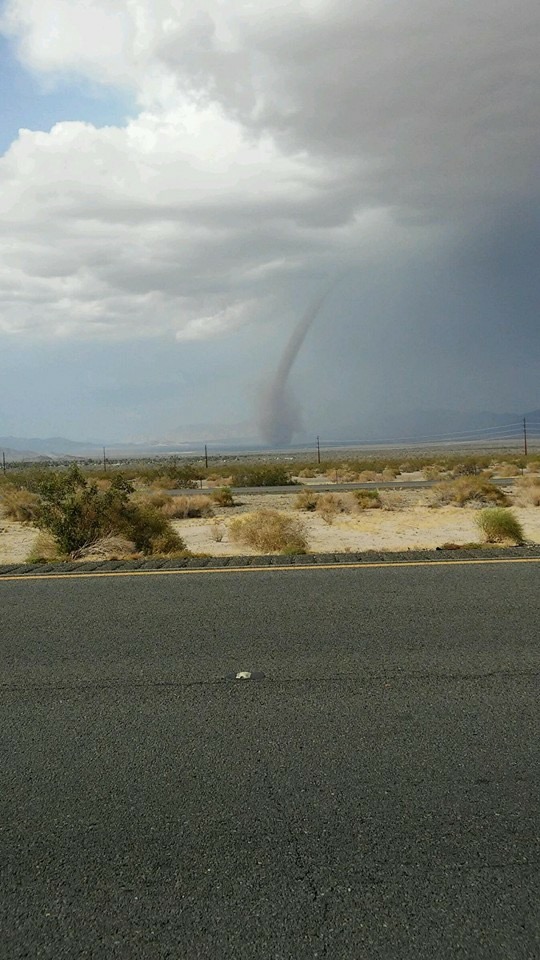
^Tornado in Chuckwalla Valley, Riverside County CA. Photo: Melissa Cruisinberry
Hidden Hills Solar Power Tower: Energy Commission Moves to Terminate
April 17, 2015 - The California Energy Commission staff made a motion today to terminate the Hidden Hills Solar Electric Generating System, mostly in response to Inyo County's Renewable Energy General Plan Amendment which had specific limitations, such as photovoltaic only (no solar thermal power towers). They said:
"Applicant’s failure to meaningfully fulfill its status report requirements, and failure to timely file a renewed request for suspension, are by themselves sufficient basis for terminating the proceeding. However, there is an additional reason that supports termination beyond 'failure to pursue with due diligence.' That reason is the recent adoption by Inyo County of a Renewable Energy Plan (General Plan Amendment No. 2013-02). The general plan amendment (Amendment) was the product of Inyo County’s participation in the Desert Renewable Energy Conservation Plan, and was financed with grant funding from the Energy Commission to do comprehensive planning on the county level for renewable energy development. (Inyo Co. Resolution No. 2015- 26, March 24, 2015, p.2.) The Amendment is the product of extensive public outreach, consultation with public agencies, consultation with Native American tribes, and a full- blown environmental impact report process that considered extensive project alternatives. (Id., pp. 2-11.)"
More >>here.
Judges Hear Arguments in Two Cases Against Ivanpah Solar Project
April 10, 2015 - Pasadena CA - A three judge panel of the 9th Circuit heard from both sides in two cases challenging the Ivanpah Solar Electric Generating System in San Bernardino County CA -- Western Watersheds Project objected to its lack of proper environmental review, and the Native American group La Cuna de Aztlan objected to restriction of religious freedom. More >>here.
Our Report on the Inyo County Supervisors Hearing on the REGPA
April 4, 2014 - The March meeting to discuss the Renewable Energy General Plan Amendment, with public comment, and far-reaching concerns for the Desert Renewable Energy Conservation Plan, >>here.
Conservationists Ask for New Decision on the Searchlight Wind Project
March 12, 2015 - Last week conservation groups, including Basin & Range Watch, asked the U.S. District Court in Reno, Nevada to order Secretary of the Interior Sally Jewell to take a fresh look at a controversial wind project in an area with the densest concentrations of protected golden eagles and one of the densest desert tortoise populations in Nevada. The latest motion asks Judge Miranda Du to vacate the Record of Decision and require the Secretary of the Interior to make a new decision whether to approve the project after the Bureau of Land Management and the U.S. Fish and Wildlife Service provide additional explanation for their wildlife analyses. More >>here.
"Phased Approach" to DRECP Announced
March 11, 2015 - The The Bureau of Land Management (BLM), U.S. Fish and Wildlife Service (FWS), California Energy Commission (CEC) and California Department of Fish and Wildlife (CDFW) yesterday announced the next steps in the Desert Renewable Energy Conservation Plan (DRECP) after the close of the comment period.
According to the press release from www.drecp.org, based on an initial review of public comments received (12,000 or so were received) on the draft DRECP that were submitted by a diverse group of stakeholders, the agencies are adjusting the planning process and will use a phased approach to approve the plan's three fundamental components: the BLM Land Use Plan Amendment; federal General Conservation Plan; and the state Natural Community Conservation Plan.
The agencies will start by completing the BLM component of the DRECP that designates development focus areas and conservation areas on public lands while providing additional time for the state and federal agencies to work with counties and other stakeholders to address issues and concerns with the General Conservation Plan and the Natural Community Conservation Plan components, including the proposed permitting processes.
Continued engagement with the counties will help determine the best options and timing for proceeding with the private land components and better align renewable energy development and conservation at the local, state and federal level. It will also allow the agencies to explore opportunities for a tailored, county-by-county approach that fits with the DRECP plan.
What we really think may be happening is the counties are pushing back against this massive renewable energy development plan, so the agencies are delaying implementation of the private lands component until later, and moving forward instead with the mostly-federal lands component. But this raises the question of why a DRECP plan is necessary at all if it entails re-writing BLM land use plans for solar and wind energy that have already been written in such massive documents as the Solar Programmatic Environmental Impact Statement, which already has Solar Energy Zones and areas set aside for non-development.
See more at Chris Clarke's KCET ReWire blog.
Desert Quartzite Solar Project Moving Forward
March 5, 2015 - In the Federal Register this morning: the Bureau of Land Management has opened up the official review for the Desert Quartzite Solar Project, a First Solar photovoltaic thin-film facility. This will be located near Blythe, California and will be about 2,500 acres. It will be just south of the community of Mesa Verde. The residents of Mesa Verde are now complaining about all of the dust that is being kicked up from the Blythe Solar Farm being bulldozed right now. The project could threaten desert tortoises, Mojave fringe-toed lizards, and Yuma clapper rails.
Public scoping comments will be accepted until April 6th. They can be mailed to
blm_ca_desert_quartzite_solar_project@blm.gov. The comment deadline is April , 2015. Here is the link to the Federal Register Notice: http://www.gpo.gov/fdsys/…/FR-2015-03-06/html/2015-05290.htm
Basin & Range Watch Comment Letter on the DRECP
January 30, 2015 - Basin & Range Watch submitted this comment letter today to the Desert Renewable Energy Conservation Plan website. Instead of massive bulldozing of desert ecosystems and fragmentation of rural communities, we propose an alternative that utilizies the California Energy Efficiency Strategic Plan, which is already state law. Enough rooftop and parking lot sites exist to more than fulfill the California electricity need, as well as pushing for more energy efficiency to save energy. More >>here.
